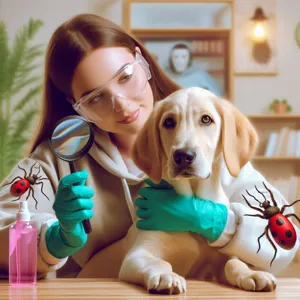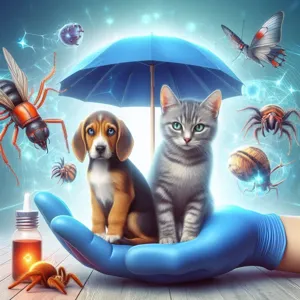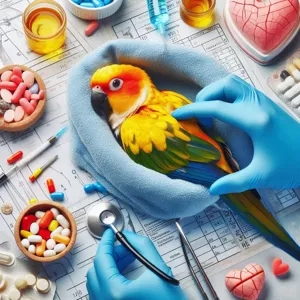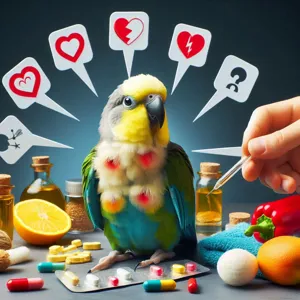As a devoted pet parent, ensuring your furry friend receives the best nutrition is paramount to their health and happiness.
With countless dog food brands on the market, it can be overwhelming to determine which ones truly deliver quality ingredients and balance for your beloved companion. From kibble to wet food, each option varies significantly in terms of nutritional value, flavor, and ingredient quality. In this comprehensive guide, we’ll explore the top 10 dog food brands that have earned a reputation for excellence, focusing on their commitment to providing wholesome, high-quality nutrition tailored to meet the unique needs of different breeds and life stages. Whether you have a playful puppy or a wise old hound, our curated list will help you make informed choices that promote your dog’s well-being and longevity, ensuring that mealtime is not just a routine, but a celebration of health and happiness for your four-legged family member.
1. Introduction: Why Choosing the Right Dog Food Matters

When it comes to our beloved canine companions, choosing the right dog food is one of the most crucial decisions pet owners can make. Just like humans, dogs require a well-balanced diet to thrive, and the food we provide them can profoundly impact their overall health, energy levels, and longevity. With a plethora of brands and options flooding the market, the task of selecting the perfect dog food can feel overwhelming. However, understanding the importance of quality nutrition is the first step in ensuring your furry friend leads a happy and healthy life.
The right dog food not only supports your pet’s physical health but can also influence their behavior, coat condition, and digestive system. High-quality ingredients packed with essential nutrients can help prevent common health issues, such as obesity, allergies, and gastrointestinal problems. Moreover, dogs have unique dietary needs that vary by age, breed, and activity level. A growing puppy requires different nutrients than a senior dog, and active breeds may thrive on a protein-rich diet, while others may need a focus on weight management.
By investing time in researching dog food brands and understanding their ingredient labels, pet owners can make informed choices that cater to their dogs’ specific needs. In this blog post, we will explore the top 10 dog food brands that not only prioritize high-quality ingredients but also demonstrate a commitment to the health and well-being of your furry friend. Let’s dive in and discover the options that can help keep tails wagging and spirits high!
2. Key Nutritional Needs for Dogs
When it comes to selecting the right dog food, understanding your furry friend’s key nutritional needs is essential for promoting a long and healthy life. Dogs, like humans, have specific dietary requirements that must be met to ensure they thrive. Here are the fundamental nutritional components that should be included in any high-quality dog food:
**1. Protein:** Dogs are omnivores, but they require a good amount of protein for muscle development, energy, and overall health. Look for dog foods that list a high-quality source of protein—such as chicken, beef, or fish—as the first ingredient. Protein should make up a significant portion of your dog’s diet, especially for active breeds.
**2. Fats:** Healthy fats are crucial for maintaining a shiny coat and healthy skin. They provide a concentrated source of energy and support cell function. Omega-3 and Omega-6 fatty acids are particularly important, so look for dog foods that include fish oil or flaxseed oil in their ingredient lists.
**3. Carbohydrates:** While dogs don’t necessarily require carbohydrates, they can benefit from them as a source of energy. Whole grains such as brown rice, barley, and oats are excellent options, as they also provide fiber, which aids in digestion. However, it’s essential to avoid fillers like corn and wheat, which can be hard for some dogs to digest.
**4. Vitamins and Minerals:** A balanced diet should include a range of vitamins and minerals to support various bodily functions. Essential nutrients like calcium, phosphorus, and vitamins A, D, and E play vital roles in bone health, immune function, and overall vitality. Quality dog foods will include these nutrients in appropriate proportions.
**5. Water:** Although not a food component, access to fresh water should never be overlooked. Proper hydration is essential for digestion, nutrient absorption, and maintaining healthy body temperature. Always ensure your dog has access to clean, fresh water to complement their diet.
By prioritizing these nutritional needs when selecting a dog food brand, you can help ensure that your beloved pet receives the quality nutrition they deserve. The right food can contribute to their energy levels, coat condition, and overall well-being, allowing them to live a happy and active life by your side.
3. Factors to Consider When Selecting Dog Food

When it comes to selecting the right dog food, there are several essential factors to consider that will ensure your furry friend receives the best nutrition tailored to their specific needs. First and foremost, age plays a crucial role in determining the appropriate diet. Puppies, adult dogs, and seniors have distinct nutritional requirements that must be met to support their growth, energy levels, and overall health.
Next, take into account your dog’s breed and size. Larger breeds may require a diet that promotes joint health and slows down growth to prevent developmental issues, while smaller breeds often benefit from nutrient-dense formulas that cater to their higher metabolism. Additionally, consider any specific health concerns or dietary restrictions your dog might have, such as allergies, sensitivities, or medical conditions that necessitate a specialized diet.
Ingredients are another critical aspect to scrutinize. High-quality dog food should list meat as the primary ingredient, supplemented by a balanced mix of fruits, vegetables, and whole grains. Avoid foods that contain fillers, artificial preservatives, or by-products, as these can detract from your dog’s health. Look for brands that are transparent about their sourcing and manufacturing processes, as well as those that adhere to high safety and quality standards.
Lastly, consider your dog’s personal preferences. While nutrition is key, palatability matters too! Some dogs may have particular tastes or textures they enjoy more than others. It might take a bit of experimentation to find a food that not only meets their nutritional needs but also delights their taste buds. By taking these factors into account, you can confidently choose a dog food brand that ensures your beloved companion thrives with every meal.
4. Overview of the Top 10 Dog Food Brands
When it comes to nourishing our beloved dogs, selecting the right food can feel overwhelming, given the plethora of options available on the market. To help simplify your decision-making process, we’ve compiled an overview of the top 10 dog food brands that consistently deliver quality nutrition, backed by research and trusted by pet owners worldwide.
1. **Royal Canin**: Renowned for its breed-specific formulas, Royal Canin offers tailored nutrition that meets the unique needs of various dog breeds, sizes, and life stages. Their commitment to research and development ensures that each kibble is designed to promote optimal health and vitality.
2. **Hill’s Science Diet**: Often recommended by veterinarians, Hill’s Science Diet focuses on scientifically formulated recipes that address specific health issues such as weight management, digestive health, and skin sensitivity. Their dedication to high-quality ingredients makes them a go-to for health-conscious pet owners.
3. **Blue Buffalo**: Known for their natural ingredients, Blue Buffalo emphasizes whole food nutrition, free from artificial preservatives and by-products. Their “Life Protection Formula” is crafted to support a healthy immune system and overall well-being, making it a favorite among dog lovers.
4. **Orijen**: For those looking for a biologically appropriate diet, Orijen stands out with its high-protein, grain-free recipes. Packed with fresh and raw animal ingredients, this brand mirrors a dog’s ancestral diet, promoting peak health and energy levels.
5. **Wellness core**: This brand emphasizes grain-free and high-protein recipes that cater to active dogs. With a focus on wholesome ingredients, Wellness Core supports your dog’s health while keeping them satisfied and energized.
6. **Nutro Ultra**: Known for its trio of proteins from chicken, lamb, and salmon, Nutro Ultra delivers a rich source of flavor and vital nutrients. The brand’s emphasis on real, recognizable ingredients makes it a popular choice for pet owners who prioritize quality in their dog’s diet.
7. **Merrick**: With a commitment to using locally sourced ingredients, Merrick offers grain-free recipes that are rich in protein and healthy fats. Their “Farm to Bowl” philosophy ensures that dogs receive wholesome nutrition with every meal.
8. **Taste of the Wild**: Inspired by the diets of wild canines, Taste of the Wild provides grain-free options featuring real roasted meats and sustainable ingredients. Their unique flavors, such as roasted bison and roasted venison, keep mealtime exciting for your furry friend.
9. **Canidae**: This brand prides itself on providing premium nutrition with its “All Life Stages” formulas, suitable for dogs of all ages and sizes. Canidae’s focus on simple, wholesome ingredients ensures a balanced diet that supports overall health.
10. **Solid Gold**: With a commitment to holistic nutrition, Solid Gold features a variety of recipes that include superfoods like pumpkin and quinoa. Their focus on gut health and digestibility makes Solid Gold a fantastic option for dogs with sensitive stomachs.
Each of these brands brings something unique to the table, ensuring that whether your dog is a tiny teacup or a giant Great Dane, there’s a quality option to meet their nutritional needs. By choosing a brand from this list, you can feel confident that you’re providing your furry friend with the best possible nutrition for a healthy and happy life.
5. Brand #1: [Brand Name] – Ingredients and Benefits

### 5. Brand #1: Blue Buffalo – Ingredients and Benefits
When it comes to providing your furry friend with the best nutrition, Blue Buffalo stands out as a top contender in the dog food market. Founded on the principles of promoting health and well-being, Blue Buffalo ensures that every bite is packed with quality ingredients that cater to the unique needs of your dog.
The first thing that sets Blue Buffalo apart is their commitment to using real meat as the primary ingredient in their recipes. Whether it’s chicken, beef, or fish, the protein source is always of high quality, supporting muscle development and energy levels. Alongside these proteins, Blue Buffalo incorporates wholesome grains like brown rice and barley, providing essential carbohydrates for sustained energy throughout the day.
But Blue Buffalo doesn’t stop there. Their formulas are enriched with a blend of antioxidants, vitamins, and minerals that contribute to your dog’s overall health. The LifeSource Bits—a proprietary blend of nutrients—are cold-formed to preserve their potency, ensuring your dog gets the maximum benefits from every meal. These bits support immune system health, promote a healthy oxidative balance, and help improve the overall quality of your dog’s coat and skin.
Additionally, Blue Buffalo offers grain-free options for dogs with sensitivities or allergies, using alternative carbohydrates like sweet potatoes and peas. This adaptability means you can find a formula that’s just right for your pet, no matter their dietary needs.
The benefits of feeding your dog Blue Buffalo extend beyond just nutrition; it’s about enhancing their quality of life. With flavors that pets crave and ingredients you can trust, Blue Buffalo provides a comprehensive approach to canine health. So, if you’re looking for a dog food brand that prioritizes quality nutrition, look no further than Blue Buffalo—your furry friend will thank you!
6. Brand #2: [Brand Name] – Ingredients and Benefits
### 6. Brand #2: Wellness Core – Ingredients and Benefits
Wellness Core is a premium dog food brand that emphasizes the importance of a high-protein diet, designed specifically to cater to the nutritional needs of active dogs. With its commitment to using only the finest ingredients, Wellness Core stands out as a top choice for pet owners who want to fuel their furry friends with quality nutrition.
The ingredient list is impressive, featuring real meat as the first component, ensuring that your dog receives the essential amino acids necessary for muscle development and energy. The primary protein sources, such as turkey, chicken, and salmon, are complemented by wholesome grains and vegetables, including brown rice, peas, and sweet potatoes. This combination not only delivers a rich protein profile but also provides a balanced array of vitamins and minerals to support overall health.
One of the standout features of Wellness Core is its grain-free formula, which is ideal for dogs with sensitivities or allergies to wheat and other grains. Instead, it incorporates nutrient-dense ingredients like chickpeas and lentils, which not only offer fiber for digestive health but also keep your dog feeling satiated. Additionally, the inclusion of probiotics promotes a healthy gut, aiding in digestion and nutrient absorption.
The benefits don’t stop there. Wellness Core is fortified with antioxidants, omega fatty acids, and essential vitamins, all of which contribute to healthy skin and a shiny coat, strong teeth, and a robust immune system. The brand also prides itself on being free from artificial colors, flavors, and preservatives, providing peace of mind for conscientious pet owners.
Overall, Wellness Core is more than just dog food; it’s a commitment to your dog’s health and well-being. With its focus on high-quality, wholesome ingredients and a variety of flavors to choose from, it’s no wonder that this brand is beloved by both dogs and their owners alike. Choosing Wellness Core means investing in the vitality and happiness of your four-legged companion.
7. Brand #3: [Brand Name] – Ingredients and Benefits

### Brand #3: Wellness Core – Ingredients and Benefits
Wellness Core stands out as a premium dog food brand that epitomizes the mantra of “quality over quantity.” With a focus on grain-free recipes, this brand is dedicated to providing high-protein nutrition to support your dog’s overall health and vitality.
The ingredient list reads like a gourmet menu for your furry friend. The primary component is high-quality meat, whether it’s chicken, turkey, or fish, ensuring that your dog receives the essential amino acids necessary for muscle development and energy. Supplemented with a blend of wholesome vegetables like sweet potatoes and peas, Wellness Core not only serves up essential carbohydrates but also provides a rich source of vitamins and minerals.
Moreover, the inclusion of probiotics promotes healthy digestion, while omega fatty acids work wonders for skin and coat health, giving your dog that enviable shine. Each bite is packed with antioxidants from fruits and vegetables, supporting a robust immune system and overall well-being.
What truly sets Wellness Core apart is their commitment to transparency. Each formula is meticulously crafted without fillers, artificial colors, or preservatives, making it a trustworthy choice for pet owners who prioritize clean eating for their pets.
Choosing Wellness Core means investing in your dog’s health, ensuring that every meal is not just a necessity but a delightful experience that nourishes and energizes your beloved companion. With a loyal following among dog owners, it’s clear that Wellness Core is a brand that delivers on its promise of quality nutrition, making it an excellent choice for your furry friend’s diet.
8. Brand #4: [Brand Name] – Ingredients and Benefits
### 8. Brand #4: Wellness Core – Ingredients and Benefits
Wellness Core stands out in the crowded dog food marketplace with its commitment to high-quality, protein-rich nutrition that caters to the specific dietary needs of dogs of all ages and sizes. This brand prides itself on using premium, natural ingredients that promote overall health and vitality.
The foundation of Wellness Core is its unique blend of real meat, including turkey, chicken, and fish, which serves as the primary protein source. These high-quality proteins are essential for maintaining muscle mass and energy levels, ensuring your furry friend remains active and vibrant. In addition to the protein content, Wellness Core is grain-free, making it an excellent choice for dogs with sensitivities to grains or those prone to allergies.
One of the standout features of Wellness Core is its incorporation of nutrient-dense superfoods like blueberries, spinach, and sweet potatoes. These ingredients are packed with antioxidants, vitamins, and minerals that support immune function and contribute to overall well-being. The inclusion of healthy fats, such as omega-3 and omega-6 fatty acids, helps promote a shiny coat and healthy skin, while also supporting brain and eye health.
Moreover, Wellness Core takes digestive health seriously. Each formulation includes probiotics and prebiotics, which work together to promote a balanced gut microbiome, aiding in nutrient absorption and ensuring your dog’s digestive system functions optimally.
With a variety of flavors and formulations, including options for weight management and puppy-specific recipes, Wellness Core offers something for every dog. Choosing this brand means investing in your pet’s health with ingredients that are not only nutritious but delicious, making mealtime an enjoyable experience for your beloved companion. In summary, Wellness Core’s dedication to quality ingredients and holistic nutrition makes it a top choice for dog owners seeking to provide their pets with the best possible diet.
9. Brand #5: [Brand Name] – Ingredients and Benefits
### 9. Brand #5: Wellness Core – Ingredients and Benefits
Wellness Core stands out in the crowded market of dog food brands with its commitment to providing a grain-free, high-protein option designed to meet the nutritional needs of active dogs. This premium brand emphasizes the use of real meat as the first ingredient, ensuring that your furry friend receives the essential protein required for muscle development and overall health.
The standout feature of Wellness Core is its carefully selected ingredients, which include turkey, chicken, and haddock, offering a blend of proteins that cater to different dietary preferences and sensitivities. Accompanied by a variety of fruits and vegetables such as blueberries, carrots, and sweet potatoes, this formula not only provides essential vitamins and minerals but also supports healthy digestion and immune function.
In addition to its impressive ingredient list, Wellness Core includes probiotics and antioxidants, promoting gut health and enhancing your dog’s natural defenses against illness. The absence of grains, fillers, and artificial additives means you can feel confident that your pup is enjoying a meal that is both nutritious and wholesome.
Wellness Core’s commitment to quality extends beyond just ingredients; they prioritize sustainable sourcing and manufacturing practices, ensuring that each bag of dog food meets high standards of safety and efficacy. With a variety of recipes tailored for different life stages and specific dietary needs, Wellness Core is a brand that’s dedicated to keeping your furry friend healthy, happy, and full of vitality.
Choosing Wellness Core means choosing a holistic approach to your dog’s nutrition, providing them with the energy they need to lead an active lifestyle while nurturing their overall well-being.
10. Brand #6: [Brand Name] – Ingredients and Benefits
### 10. Brand #6: Blue Buffalo – Ingredients and Benefits
When it comes to premium dog food, Blue Buffalo consistently stands out as a favorite among pet owners seeking quality nutrition for their furry friends. Founded on the principle of providing wholesome ingredients, Blue Buffalo prides itself on using real meat, fruits, and vegetables, ensuring that every bite is packed with the essential nutrients dogs need for a healthy, active life.
**Ingredients:**
Blue Buffalo’s recipes are crafted with the finest natural ingredients, free from artificial preservatives, colors, and flavors. Their chicken, beef, or lamb is always the primary ingredient, providing a rich source of protein to support muscle development and overall vitality. Alongside high-quality meat, Blue Buffalo incorporates whole grains such as brown rice and oats, which offer fiber for healthy digestion. Additionally, they include a variety of antioxidant-rich fruits and vegetables, like blueberries and carrots, that not only enhance the flavor but also contribute to a well-rounded diet.
**Benefits:**
The benefits of feeding your dog Blue Buffalo are numerous. The high protein content supports optimal growth and energy levels, making it an excellent choice for active dogs. Their unique LifeSource Bits, a blend of vitamins and minerals, are specifically formulated to support immune system health, life stage needs, and a healthy oxidative balance. Furthermore, Blue Buffalo offers grain-free options for dogs with sensitivities, ensuring that even those with dietary restrictions can enjoy a nutritious meal.
In addition to physical health, Blue Buffalo is committed to the well-being of dogs in every aspect of their lives, from supporting shiny coats with omega fatty acids to promoting healthy joints with glucosamine. With a variety of formulas tailored to specific breeds, sizes, and dietary needs, Blue Buffalo remains a trusted brand that emphasizes not just what goes into their food, but also the love and care that goes into every bag. Choosing Blue Buffalo means choosing a nourishing diet that can help your furry friend thrive!
11. Brand #7: [Brand Name] – Ingredients and Benefits
### Brand #7: [Brand Name] – Ingredients and Benefits
When it comes to providing optimal nutrition for your furry friend, [Brand Name] stands out as a trusted choice among dog owners who prioritize quality ingredients and health benefits. This brand prides itself on using only the finest, natural ingredients, ensuring that each kibble is packed with essential nutrients that cater to a dog’s specific dietary needs.
At the core of [Brand Name]’s formulation is a blend of high-quality proteins, such as real chicken, beef, or fish, which serve as the primary ingredient. These proteins not only support muscle development but also provide the energy your dog needs for their daily activities. Alongside protein, [Brand Name] incorporates a variety of wholesome grains like brown rice and oats, which offer a digestible source of carbohydrates and help maintain stable energy levels throughout the day.
What truly sets [Brand Name] apart is its commitment to including fruits and vegetables that are rich in antioxidants, vitamins, and minerals. Ingredients like sweet potatoes, blueberries, and carrots not only enhance the flavor profile but also contribute to overall health, supporting immune function and promoting a shiny coat. Additionally, the inclusion of omega fatty acids helps in maintaining skin health and reducing allergies, ensuring that your dog feels as good as they look.
Another notable aspect of [Brand Name] is its careful attention to the absence of fillers, artificial preservatives, and by-products. This dedication to purity means that every bite is nourishing and wholesome, free from unnecessary additives that could compromise your dog’s health.
As a brand, [Brand Name] is also known for its hypoallergenic options, making it a suitable choice for dogs with food sensitivities or allergies. Their tailored recipes cater to a variety of breeds and life stages, ensuring that every dog can enjoy a meal that’s right for them.
In summary, [Brand Name] not only delivers on taste but also champions the health and well-being of your canine companion. With a focus on high-quality ingredients and numerous health benefits, it’s no wonder that [Brand Name] has earned its spot as one of the top dog food brands, making it a go-to choice for pet parents who want nothing but the best for their furry friends.
12. Brand #8: [Brand Name] – Ingredients and Benefits
### Brand #8: Purely Pets – Ingredients and Benefits
When it comes to providing your canine companion with quality nutrition, Purely Pets stands out as an exemplary choice. This brand prides itself on using only the finest, all-natural ingredients, ensuring that each bowl is filled with wholesome goodness. Purely Pets crafts its formulas with real meat as the primary ingredient, offering high-quality protein that supports muscle development and overall health.
What sets Purely Pets apart is their commitment to transparency. Each bag of dog food is clearly labeled with a detailed ingredient list, allowing pet owners to make informed decisions about what they are feeding their furry friends. The brand offers a variety of recipes tailored to different life stages and dietary needs, including grain-free options for pups with sensitivities.
In addition to high-quality protein, Purely Pets incorporates a balanced blend of fruits and vegetables, providing essential vitamins, minerals, and antioxidants. Ingredients like sweet potatoes, blueberries, and carrots not only enhance the flavor but also contribute to improved digestion and a stronger immune system. The inclusion of omega fatty acids supports healthy skin and a shiny coat, while probiotics promote gut health, ensuring your dog feels their best from the inside out.
Choosing Purely Pets means investing in your dog’s health and happiness. With a focus on quality, safety, and nutritional integrity, this brand is dedicated to creating meals that your furry friend will love and thrive on. If you’re looking for a dog food that prioritizes nutrition without compromising on taste, Purely Pets is an excellent addition to your dog’s diet.
13. Brand #9: [Brand Name] – Ingredients and Benefits
### 13. Brand #9: Wellness CORE – Ingredients and Benefits
When it comes to providing your dog with balanced nutrition, Wellness CORE stands out as a premium choice in the pet food industry. Focused on the philosophy of “grain-free” nutrition, Wellness CORE is designed to cater to the dietary needs of dogs that thrive on high-protein diets. This brand emphasizes the use of quality ingredients to ensure that your furry friend receives the best possible sustenance.
**Ingredients:**
Wellness CORE recipes are crafted with real meat as the primary ingredient, ensuring that your dog gets a protein-rich meal that supports muscle development and overall health. Chicken, turkey, or fish are often the first ingredients listed, providing essential amino acids for energy and vitality. The formulations are fortified with a blend of wholesome fruits and vegetables, such as blueberries, spinach, and carrots, which not only enhance the flavor but also contribute vital vitamins, minerals, and antioxidants.
In addition to protein and produce, Wellness CORE includes healthy fats from sources like chicken fat and flaxseed, which promote healthy skin and a shiny coat. The absence of grains means fewer carbohydrates, making it an excellent choice for dogs with sensitivities or those prone to weight gain.
**Benefits:**
One of the key benefits of feeding your dog Wellness CORE is its focus on delivering optimal nutrition without unwanted fillers. This means you can expect improved digestion and energy levels in your pet as they enjoy a diet free from corn, wheat, and soy. Moreover, the rich protein content supports lean muscle growth, making it ideal for active dogs or those looking to maintain a healthy weight.
Additionally, the inclusion of probiotics aids in gut health, promoting a robust digestive system that can help prevent common gastrointestinal issues. Many pet owners report noticeable improvements in their dogs’ coat condition and overall vitality after switching to Wellness CORE, making it a favorite among those who prioritize high-quality nutrition.
In summary, if you’re seeking a dog food brand that prioritizes premium ingredients and tangible health benefits, Wellness CORE is a fantastic option to consider for your four-legged companion. Your dog will thank you with tail wags and slobbery kisses!
14. Brand #10: [Brand Name] – Ingredients and Benefits
### Brand #10: PetDelight – Ingredients and Benefits
PetDelight has carved a niche for itself in the crowded dog food market, thanks to its unwavering commitment to quality and transparency. This brand prides itself on using only the finest ingredients, ensuring that your furry friend enjoys a nutritious and wholesome meal every time.
One of the standout features of PetDelight is its use of real, high-quality proteins as the primary ingredient. Whether it’s chicken, beef, or lamb, PetDelight sources its meats from trusted farms, emphasizing grass-fed and free-range options. This not only enhances the flavor but also packs a punch when it comes to essential amino acids, supporting your dog’s muscle health and energy levels.
In addition to premium proteins, PetDelight incorporates a vibrant array of whole grains, fruits, and vegetables into its recipes. Ingredients like brown rice, sweet potatoes, and blueberries provide a balanced source of carbohydrates and antioxidants, fostering a healthy immune system and promoting overall well-being. Moreover, the inclusion of omega fatty acids from fish oil contributes to a shiny coat and healthy skin, making your dog look as good as they feel.
PetDelight also recognizes the importance of digestive health. Each formula is enriched with probiotics and prebiotics, which help maintain a balanced gut flora, ensuring that your dog’s digestive system functions smoothly. This is especially beneficial for pets that may have sensitive stomachs or food intolerances.
What sets PetDelight apart is its dedication to avoiding fillers and artificial additives. You won’t find any corn, wheat, or soy in their recipes, nor any by-products or preservatives. This commitment to purity means you can feel confident that you are feeding your dog a meal that is both safe and nutritious.
With a variety of flavors and formulations tailored to different life stages and dietary needs, PetDelight is a brand that truly prioritizes your pet’s health. Whether your dog is a playful puppy or a wise senior, there’s a PetDelight option designed to meet their specific requirements.
In summary, PetDelight combines high-quality ingredients with a thoughtful approach to nutrition, ensuring that every bowl is filled with goodness that keeps your furry friend thriving. If you’re looking for a trustworthy brand that delivers on both taste and health benefits, PetDelight is undoubtedly worth considering.
15. Conclusion: Making the Best Choice for Your Dog’s Health and Happiness
In conclusion, choosing the right dog food brand is a crucial step in ensuring your furry friend enjoys a long, healthy, and happy life. As pet owners, we have a profound responsibility to provide our dogs with the best nutrition possible, which in turn supports their overall well-being, energy levels, and even mood.
Each of the top 10 dog food brands we’ve discussed offers unique benefits and formulations tailored to meet the diverse needs of dogs, from puppies to seniors, and from small breeds to large breeds. It’s essential to consider factors such as ingredient quality, nutritional value, and your dog’s specific dietary requirements when making your selection.
Take the time to read labels, understand the sourcing of ingredients, and consult with your veterinarian to identify the best fit for your pet’s individual health needs. Remember, investing in high-quality dog food is not just about feeding your dog; it’s about nurturing them with wholesome nutrients that promote vitality and longevity.
Finally, don’t forget to pay attention to your dog’s reactions to any new food. Monitor their health, energy levels, and overall happiness, as these are key indicators of how well they’re adapting to their diet. With thoughtful choices and a little research, you can ensure that your beloved companion receives the nutrition they need to thrive. After all, a well-fed dog is a happy dog, and their wagging tails will thank you for it!
As we wrap up our exploration of the top 10 dog food brands, we hope you feel empowered to make informed decisions about your furry friend’s nutrition. Each brand highlighted in this article has been carefully selected for its commitment to quality ingredients, balanced formulations, and a focus on your dog’s overall health and well-being. Remember, what you feed your dog plays a significant role in their energy levels, coat condition, and longevity. Take the time to assess your pet’s specific needs, and don’t hesitate to consult with your veterinarian to find the best fit. By choosing high-quality dog food, you’re not just investing in a meal; you’re nurturing a happy, healthy life for your beloved companion. Here’s to many wagging tails and joyful barks as you embark on this nutritious journey together!

































